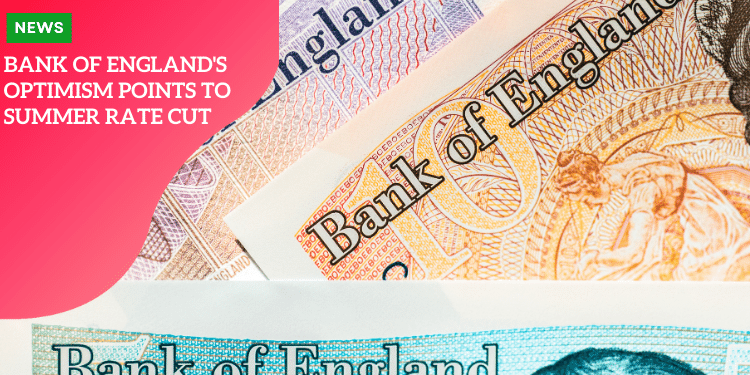Bank of England’s Optimism Points to Summer Rate Cut

Introduction
As the UK economy navigates the post-pandemic landscape, all eyes are on the Bank of England and its monetary policy decisions. With inflation currently at 3.2% and the cost of living remaining a pressing concern for many households, the central bank’s stance on interest rates holds significant implications for the nation’s financial well-being.
Under the leadership of Andrew Bailey, the Bank of England has maintained interest rates at 5.25% since last summer, aiming to strike a delicate balance between curbing inflation and supporting economic growth. This decision has been closely watched by both businesses and individuals, as it directly impacts borrowing costs for mortgages, loans, and the returns on savings accounts.
In recent statements, Bailey has expressed optimism about the direction of the economy, hinting at the possibility of a rate cut in the near future. This news has sparked speculation among economists and market analysts, who are eager to understand the factors influencing the Bank’s decision-making process.
The importance of monetary policy in shaping economic conditions cannot be overstated. By adjusting interest rates, the Bank of England wields a powerful tool to influence consumer spending, business investment, and overall economic activity. A rate cut, for instance, could provide a much-needed boost to the economy by making borrowing more affordable and encouraging spending.
However, the decision to lower rates is not without its challenges. The Bank must carefully consider a range of economic indicators, such as inflation projections, employment figures, and global market trends, to ensure that any rate adjustments are well-timed and effective.
As the nation awaits further updates from the Bank of England, it is clear that Andrew Bailey’s outlook on potential rate cuts will be a key factor in shaping the UK’s economic trajectory. With households and businesses alike eager for relief from the financial pressures of recent years, the central bank’s decisions in the coming months will be closely watched and analyzed.
In the following sections, we will delve deeper into the current economic landscape, the factors driving rate decisions, and the potential implications of a summer rate cut for the UK economy. By examining these crucial aspects, we aim to provide a comprehensive understanding of the Bank of England’s stance and its significance for the nation’s financial future.
Current Economic Landscape
The Bank of England has decided to hold interest rates steady at 5.25%, a level they’ve maintained since last summer. This decision comes as part of the Bank’s efforts to slow down the pace of consumer price increases and ease the cost of living for UK residents. By keeping borrowing costs high, the Bank aims to encourage people to reduce their spending, which in turn should lead to a decrease in demand for goods and a slowdown in price rises.
Inflation, which measures the rate at which prices rise, currently stands at 3.2%. While this is still above the Bank’s target level of 2%, Andrew Bailey, the Bank of England’s governor, has expressed optimism that inflation will fall “close” to the target level in the coming months. This positive outlook is driven by encouraging developments in the economy and a projected deceleration in price increases.
The Bank’s decision to hold rates steady directly impacts High Street banks and money lenders, as they set their own rates based on the Bank’s benchmark. As a result, people are currently paying more for borrowing money through mortgages and loans, while savers are benefiting from better returns on their deposits. This delicate balancing act between managing inflation and supporting economic growth is a key consideration for the Bank of England.
Looking ahead, the Bank has provided forecasts for economic growth in the UK. They predict growth of 0.4% for the first three months of 2024 and 0.2% from April to June. These projections are slightly more optimistic than previous estimates, partly due to an increase in population size and some measures introduced in the government’s spring Budget, such as the cut to National Insurance.
The Bank also expects inflation to continue its downward trajectory, potentially reaching 1.9% by 2026. This forecast is based on a combination of factors, including the easing of post-Covid demand pressures and stabilizing energy and food prices, which had soared following Russia’s invasion of Ukraine.
As the UK navigates this challenging economic landscape, the Bank of England remains committed to monitoring inflation levels closely and making necessary adjustments to monetary policy to support sustainable growth and financial stability. The state of the economy is likely to be a central issue in the upcoming election, with Prime Minister Rishi Sunak expressing optimism about the country’s prospects despite the ongoing financial strain on households.
Factors Driving Rate Decisions
When it comes to setting interest rates, the Bank of England has a delicate balancing act to perform. On one hand, they must consider the impact of post-Covid demand on monetary policy. The lifting of pandemic restrictions has led to a surge in consumer spending, which can drive up prices and contribute to inflation. To keep inflation in check, the Bank may need to raise interest rates, making borrowing more expensive and encouraging people to save rather than spend.
However, the Bank also has to weigh the influence of geopolitical events, such as the ongoing crisis in Ukraine. The conflict has disrupted global supply chains and pushed up energy and food prices, adding to inflationary pressures. In response, central banks around the world have been forced to tighten monetary policy, even as they try to support economic growth in the wake of the pandemic.
This brings us to the crux of the matter: the balancing act between fostering economic growth and controlling inflation. High interest rates can put a damper on business investment and employment, as companies become more cautious about borrowing and expanding. On the other hand, letting inflation run rampant can erode the purchasing power of consumers and undermine economic stability.
As Andrew Bailey, the Governor of the Bank of England, noted in a recent news conference, “It’s a balancing act, as high interest rates can harm the economy and restrict growth, as businesses hold off on investing in production and jobs.” (Bank of England ‘optimistic’ as it edges closer to summer rate cut.docx)
Ultimately, the Bank of England’s rate decisions will depend on a careful assessment of these competing factors. They will need to weigh the strength of post-Covid demand, the impact of geopolitical risks, and the potential trade-offs between growth and inflation. By striking the right balance, they can help steer the UK economy towards a sustainable recovery, while keeping price pressures under control.
Market Expectations vs. Bank’s Projections
As the Bank of England maintains its optimistic stance on the UK economy, there appears to be a notable divergence between market predictions and the central bank’s outlook. While financial markets anticipate a rate cut to 5% by August and further reductions to 4.75% by the end of the year, the Bank of England’s Governor, Andrew Bailey, suggests that the institution may need to cut rates more aggressively than what the markets are currently forecasting.
Discrepancies between market predictions and the Bank of England’s outlook
This discrepancy between market expectations and the Bank’s projections raises questions about the future trajectory of interest rates and the overall health of the UK economy. The Bank of England’s more optimistic outlook is driven by encouraging signs of inflation easing, with the expectation that it will fall close to the 2% target in the coming months. However, the central bank remains cautious, emphasizing the need for more evidence of sustained price stability before implementing any rate cuts.
Insights into the Monetary Policy Committee’s voting patterns
The Monetary Policy Committee (MPC), responsible for setting interest rates, appears to be edging closer to a rate cut. In the latest meeting, two members voted for reducing rates, while the remaining seven opted to hold them steady at 5.25%. This voting pattern suggests a growing inclination towards monetary easing, although the majority still favors a wait-and-see approach. The MPC’s decision-making process is influenced by various factors, including the post-Covid demand recovery, geopolitical events like the Ukraine crisis, and the delicate balance between fostering economic growth and controlling inflation. As the committee weighs these factors, their voting patterns serve as a valuable indicator of the likely direction of future monetary policy decisions.
Potential timeline for rate cuts and their implications on borrowers and savers
While the exact timing of rate cuts remains uncertain, the Bank of England’s optimism suggests that a reduction could occur as early as June. However, many analysts believe that August or September are more likely scenarios. The implications of these rate cuts will be felt by both borrowers and savers. For borrowers, lower interest rates could provide relief in the form of reduced mortgage payments and cheaper loans. This could stimulate consumer spending and support economic growth. On the other hand, savers may face lower returns on their deposits, potentially encouraging them to explore alternative investment options. As the UK navigates the post-pandemic economic landscape, the divergence between market expectations and the Bank of England’s projections underscores the challenges in predicting the future course of monetary policy. While the central bank remains optimistic, it is crucial for individuals and businesses to stay informed about economic developments and adjust their financial strategies accordingly.
Conclusion and Call-to-Action
In summary, the Bank of England’s optimistic outlook and potential for a summer rate cut holds significant implications for the UK economy. As Andrew Bailey, the Bank’s governor, expressed confidence in the direction of inflation and economic growth, it sets the stage for a possible reduction in interest rates as early as June, with August or September being the most likely timing.
This anticipated shift in monetary policy will have direct consequences for individuals with mortgages, loans, and savings. Lower interest rates can provide relief for borrowers, making their monthly payments more manageable. However, it’s crucial for people to stay informed about their specific financial situations and consider the long-term impact of variable rates versus fixed rates, as demonstrated by the example of Paul Day, a retiree facing a substantial increase in his mortgage payments.
On the other hand, savers may experience a slight decrease in the returns on their savings accounts. Nevertheless, the Bank’s projections indicate that the UK economy is on a path towards stability, with consumer confidence trending upward and household savings reaching their highest level since 1997, excluding the pandemic period.
As the UK navigates this critical juncture, it is essential for individuals to stay informed about economic developments and monetary policy changes. By keeping a close eye on the Bank of England’s decisions and their implications, people can make well-informed choices regarding their personal finances, whether it involves refinancing mortgages, adjusting saving strategies, or seeking professional advice. Moreover, with the UK economy taking center stage in the lead-up to the upcoming elections, it is crucial for citizens to engage in the discourse surrounding economic policies and their impact on households.
By staying informed and actively participating in the democratic process, individuals can contribute to shaping a future that prioritizes financial stability and prosperity for all. In conclusion, while the Bank of England’s optimism and potential rate cut offer a glimmer of hope, it is ultimately up to each individual to take proactive steps in managing their finances and adapting to the changing economic landscape.
Seeking guidance when needed, and making prudent decisions, we can collectively navigate this challenging period and emerge stronger on the other side.





